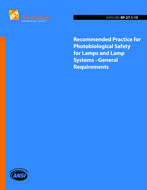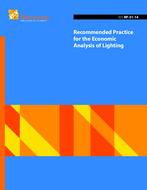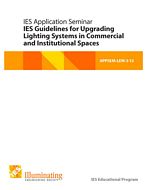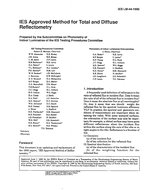Provide PDF Format
IES RP-27.1-15
- Photobiological Safety for Lamps and Lamp Systems - General Requirements
- standard by Illuminating Engineering Society, 11/06/2015
- Publisher: IES
$20.00$40.00
To evaluate a broad-band optical source, such as an arc lamp, an incandescent lamp, a fluorescent lamp, an array of lamps or a lamp system, it first is necessary to determine the spectral distribution of optical radiation emitted from the source at the point or points of nearest human access. This accessible emission spectral distribution of interestfor a lighting system may differ from that actually being emitted by the lamp alone due to the filtration by any optical elements (e.g., projection optics) in the light path. Secondly, the size, or projected size, of the source should be characterized in the retinal hazard spectral region. Thirdly, it may be necessary to determine the variation of irradiance and projected radiance (see the Glossary) with distance. The performance of the necessary measurements is not an easy task without sophisticated instruments. Users should normally rely upon the expertise of manufacturers for information on lamps and lamp systems. Safety requirements and reference measurementtechniques for lamps and specific lamp systems are provided in later standards of this series (i.e., ANSI/IES RP-27.2-00/R2010 Recommended Practice for Photobiological Safety for Lamps and Lamp Systems - Measurement Techniques and ANSI/IES RP-27.3-07 Recommended Practice for Photobiological Safety for Lamps - Risk GroupClassification Labeling). Finally, there are well known optical radiation hazards associated with some lamps and lamp systems.
The purpose of these standards is to inform the public and original equipment manufacturers (OEMs) about potential radiation hazards that may be associated with various lamps and lamp systems. It is also the purpose of these standards to provide guidance, advice, and standard methods for evaluating and informing the user, both the public and the OEM, about the potential optical radiation hazards that may be associated with these products.
This Recommended Practice covers the evaluation and control of optical radiation hazards from all electrically powered sources of optical radiation that emit in the wavelength range from 200 nm through 3,000 nm (3.0 um [micrometers]) except for light emitting diodes (LEDs) used in optical fiber communication systems and for lasers which are covered in a separate series of ANSI (American National Standards Institute) standards (SeriesZ136). Federal mandatory requirements for lamps subject to specific Federal Regulations take precedenceover requirements in subsequent standards included in this series.
Note 1: Units of wavelength in this document are exclusively in nanometers (nm).
Note 2: Subtended angles are denoted by the full included angle, not the half angle.
The purpose of these standards is to inform the public and original equipment manufacturers (OEMs) about potential radiation hazards that may be associated with various lamps and lamp systems. It is also the purpose of these standards to provide guidance, advice, and standard methods for evaluating and informing the user, both the public and the OEM, about the potential optical radiation hazards that may be associated with these products.
This Recommended Practice covers the evaluation and control of optical radiation hazards from all electrically powered sources of optical radiation that emit in the wavelength range from 200 nm through 3,000 nm (3.0 um [micrometers]) except for light emitting diodes (LEDs) used in optical fiber communication systems and for lasers which are covered in a separate series of ANSI (American National Standards Institute) standards (SeriesZ136). Federal mandatory requirements for lamps subject to specific Federal Regulations take precedenceover requirements in subsequent standards included in this series.
Note 1: Units of wavelength in this document are exclusively in nanometers (nm).
Note 2: Subtended angles are denoted by the full included angle, not the half angle.
Related Products
IES APPSEM LEM-3-13
IES Application Seminar - IES Guidelines for Upgrading Lighting Systems in Commercial and Institutio..
$30.00 $60.00





